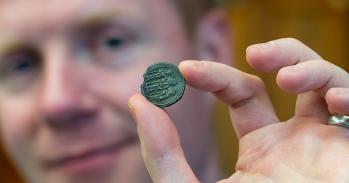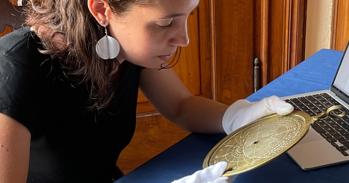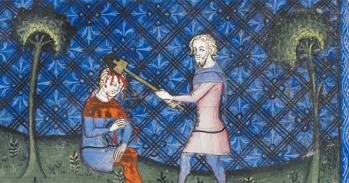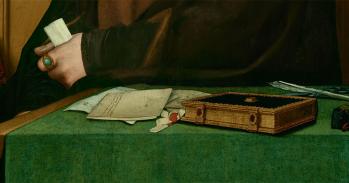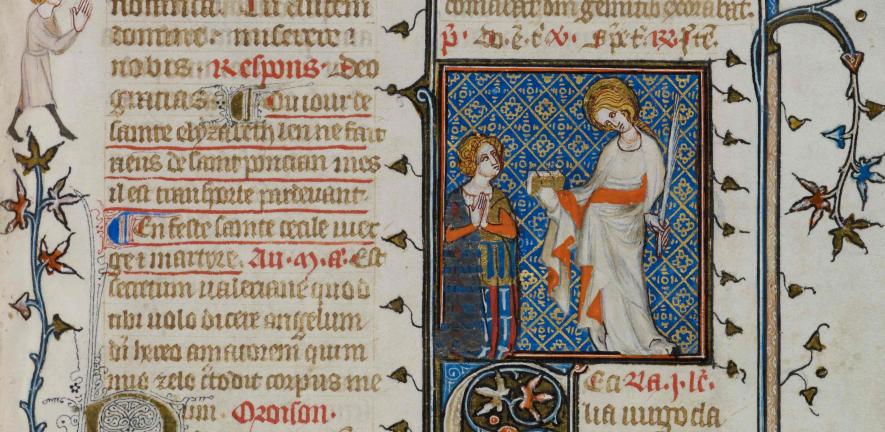
Art historian Professor Paul Binski describes his ventures into the gold-embellished world of illuminated manuscripts.
Art historian Professor Paul Binski describes his ventures into the gold-embellished world of illuminated manuscripts.
Cambridge is a wonder-world for the study of medieval illuminated manuscripts. The Fitzwilliam Museum, the University Library and the Colleges possess treasures of international quality rivalling those in the British Library, or even the Vatican. In 2005, their sheer splendour hit the headlines when many of the best manuscripts were displayed at The Fitzwilliam Museum in The Cambridge Illuminations exhibition, one of the Museum’s most successful ever held. The power of these often tiny, sometimes grand, but always intriguing objects to attract and fascinate the public remains undiminished. A manuscript is a magical little world into which we peer.
But behind every exhibition lies a great deal of expert academic work to unearth the truth of these often complex and sometimes downright obscure books. It is at this moment that experts in manuscript illumination, including art historians like myself, come in to help.
In Monty’s footsteps
Until quite recently, no-one was quite sure exactly how many illuminated manuscripts were owned by the University and kept in the University Library – nor was there any up-to-date catalogue of them. The only attempt to track all of the manuscripts down and catalogue them had been carried out by the brilliant Victorian scholar and writer of atmospheric ghost stories Dr M. R. James (‘Monty’), Provost of King’s College and one of my heroes.Monty had his own distinct way of working. Librarians would send him manuscripts, which he catalogued while sitting up in bed at King’s. Working with daunting speed, he made his way through most of the Cambridge collections and pencilled a nearly complete catalogue of the University Library manuscripts in the 1930s. However, it was never published and, since his time, the collection has continued to grow.
As a Cambridge research student working on medieval art in the 1980s, I had occasionally made forays into the collection following in Monty’s footsteps, but it wasn’t until 1995 when I joined the History of Art Department in Cambridge that I hatched a plan which Monty himself might have saluted, or so I hoped – to re-catalogue all the Cambridge collections to modern standards, and illustrate them comprehensively.
A team effort
My plan of attack was to get the one man vital to this enterprise ‘on side’, my old friend Dr Patrick Zutshi, by then Keeper of Manuscripts in the University Library. Together we decided that the best starting point for such a project would be the University Library itself. With the aid of a grant from the Gladys Krieble Delmas Foundation, we set to work with the assistance of Dr Stella Panayotova, who subsequently went on to extend the project to the Colleges and The Fitzwilliam as we had hoped.
Now – and after many summers during which I simply disappeared into the University Library, escaped College and University politics, and peacefully catalogued its collection – we have between us produced a comprehensive catalogue of the 472 manuscripts which we thought could usefully be described as illuminated or decorated.
Collecting history
The University Library’s collection turns out to be quite extraordinarily rich and extensive: it spans 700 years of illumination – from the oldest, the 9th-century Book of Cerne, to the youngest, the Italian Renaissance books of the 16th century. About 60% of the manuscripts are British, and many of the most important European ‘schools’ of illumination are represented.
We needed to explore more deeply how the collection itself had formed. When it was first created, the University Library was a working collection of textbooks which were seldom illuminated – they were basically practical working texts. The University collection certainly existed by 1400, and has an early catalogue dating to 1424, but most of the decorated books came into the collection much later.
The earliest great illuminated manuscripts found their way into the Library after the Dissolution of the Monasteries in the 16th century, and had come from such great and wealthy monastery libraries as Canterbury, Bury and Norwich. These manuscripts, crafted by skilled illuminators over many months, were for devotional purposes.
Collectors engaged in salvaging the monastic libraries, such as Matthew Parker, Archbishop of Canterbury, began a tradition of benefaction which slowly built up the University collection in the post-medieval period: Richard Holdsworth, John Moore, Bishop of Norwich and Ely, and George I were among the great collectors or donors in the 17th and 18th centuries.
In fact, what the Library collection shows is how tastes and collecting opportunities changed. Salvaging monastic libraries meant gaining large and elegantly decorated Romanesque books; whereas, by the 19th century, collecting tastes were favouring the smaller, prettier, Books of Hours (containing prayers for different times of the day) which started to enter the Library.
The treasure trove unfolds
We found no shortage of world-class highlights. There is the beautiful early 13th-century Bestiary, a compendium of fabulous and real beasts; the only surviving copy of the Life of St Edward the Confessor by the great chronicler Matthew Paris; the tiny Breviary that belonged to Marie de St Pol illuminated on parchment so white and thin as to be like the finest kid glove; or the stunning 15th-century Douze Dames de Rhetorique, with tiny paintings of the canals of Flanders; the first complete illustrated Chaucer; as well as beautifully illustrated scientific manuscripts.
But the whole point of a catalogue is to cover the smaller, less glamorous, but just as important, items. For instance, we had no idea of the extent and beauty of the Romanesque manuscripts from Cistercian monasteries in northern England. Some manuscripts were virtually unknown, such as a little Breviary made in the area of Westminster towards 1400.
Even fragments were full of potential, like the Parisian polyphonic musical notation (combining, for the first time, distinct lines of music) on some leaves in a manuscript from Bury St Edmunds. This may be amongst the earliest examples of polyphony of that type known, to judge from the style of their illumination. By reconstructing the original contents of one of the compilations – a book drawn up in the early 14th century which contains an early diagram of the human brain and its ventricles following the theories of the Arab Avicenna – we now know that it was planned to go with a manual on confession, science and religion.
A catalogue consists of thousands of sometimes tiny insights from which a bigger picture builds up. Such work can’t be rushed – catalogues are never perfect, but they have to be as ‘right’ as possible in order to last. So each manuscript was combed over repeatedly until it yielded up its secrets, often after years of work. Every book was carefully measured, its text and decoration described, and its subsequent history worked out from minute clues about ownership and provenance.
The physical pleasure of handling books of this age is not to be underestimated. Manuscripts are indeed little worlds, and to enter them we need many different skills, huge reserves of patience and sharp eyesight. But our collaboration on this project has above all been immense fun, indeed a once-in-a-lifetime opportunity. We will miss it.
For more information, please contact Professor Paul Binski (pb214@cam.ac.uk) at the Department of the History of Art and Dr Patrick Zutshi (pnrz2@cam.ac.uk) at the University Library.
This work is licensed under a Creative Commons Licence. If you use this content on your site please link back to this page.


